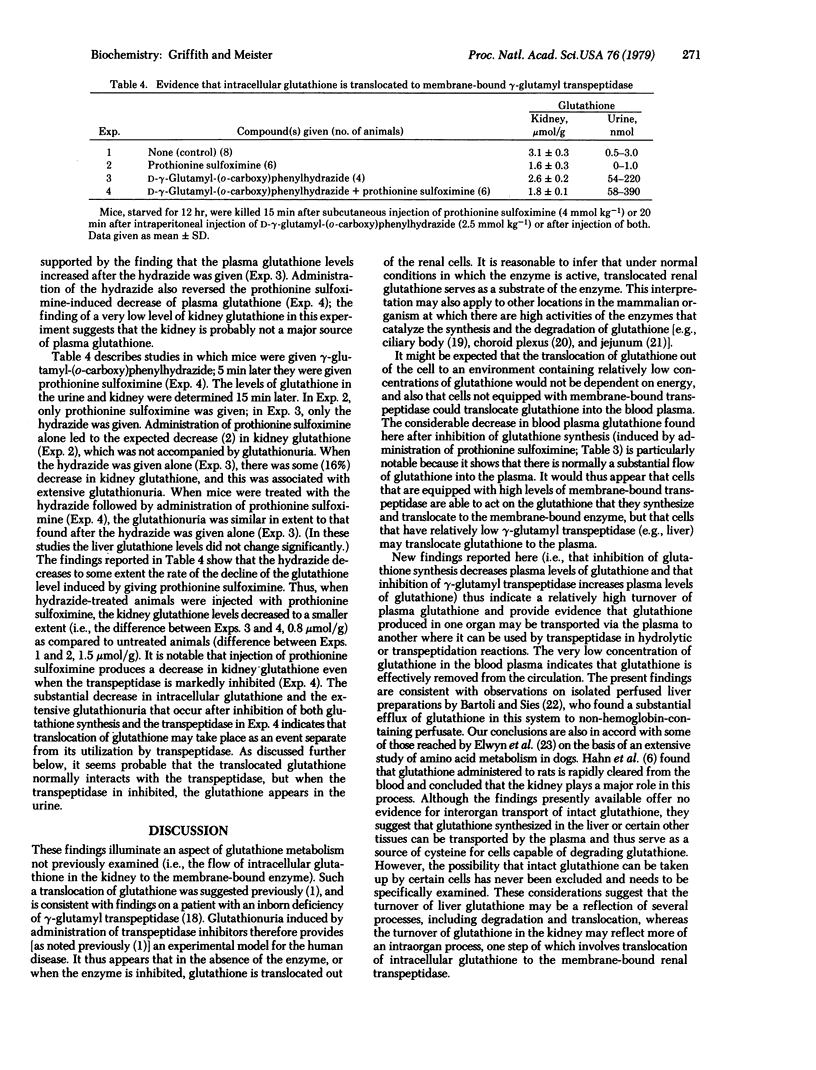Abstract
Several inhibitors of γ-glutamyl transpeptidase in vitro [L-serine plus borate, 6-diazo-5-oxo-L-norleucine, and L- and D-γ-glutamyl-(o-carboxy)phenylhydrazide] are active in vivo, as indicated by their effect in decreasing the conversion of administered D-γ-glutamyl-L-α-amino[14C]butyrate to respiratory 14CO2 in mice. The hydrazides (both L and D isomers) are the most potent inhibitors in vitro and in vivo. Inhibition of γ-glutamyl transpeptidase in vivo by the hydrazides is accompanied by extensive glutahionuria. The evidence suggests that a substantial fraction of the urinary glutathione arises from the kidney. The findings support the view that renal intracellular glutathione is normally translocated to the membrane-bound γ-glutamyl transpeptidase as a separate step in the γ-glutamyl cycle. Studies on in vivo inhibition of glutathione synthesis and of γ-glutamyl transpeptidase provide direct evidence that glutathione is normally translocated from tissues to the blood plasma and that the turnover of plasma glutathione is relatively high. The data suggest that the low but significant steady-state level of glutathione in the plasma reflects synthesis of glutathione (predominantly in the liver) and its utilization by γ-glutamyl transpeptidase (predominantly in the kidney). Thus, glutathione synthesized in cells that have transpeptidase may be translocated to and used by the membrane-bound enzyme, whereas glutathione synthesized in cells that lack the transpeptidase may be transported via the plasma to transpeptidase located on the membranes of other cells.
Keywords: prothionine sulfoximine, γ-glutamyl hydrazides, 6-diazo-5-oxonorleucine, kidney, glutathionemia
Full text
PDF




Selected References
These references are in PubMed. This may not be the complete list of references from this article.
- Bartoli G. M., Sies H. Reduced and oxidized glutathione efflux from liver. FEBS Lett. 1978 Feb 1;86(1):89–91. doi: 10.1016/0014-5793(78)80105-7. [DOI] [PubMed] [Google Scholar]
- Cornell J. S., Meister A. Glutathione and gamma-glutamyl cycle enzymes in crypt and villus tip cells of rat jejunal mucosa. Proc Natl Acad Sci U S A. 1976 Feb;73(2):420–422. doi: 10.1073/pnas.73.2.420. [DOI] [PMC free article] [PubMed] [Google Scholar]
- Elwyn D. H., Parikh H. C., Shoemaker W. C. Amino acid movements between gut, liver, and periphery in unanesthetized dogs. Am J Physiol. 1968 Nov;215(5):1260–1275. doi: 10.1152/ajplegacy.1968.215.5.1260. [DOI] [PubMed] [Google Scholar]
- Griffith O. W., Bridges R. J., Meister A. Evidence that the gamma-glutamyl cycle functions in vivo using intracellular glutathione: effects of amino acids and selective inhibition of enzymes. Proc Natl Acad Sci U S A. 1978 Nov;75(11):5405–5408. doi: 10.1073/pnas.75.11.5405. [DOI] [PMC free article] [PubMed] [Google Scholar]
- Griffith O. W., Meister A. Selective inhibition of gamma-glutamyl-cycle enzymes by substrate analogs. Proc Natl Acad Sci U S A. 1977 Aug;74(8):3330–3334. doi: 10.1073/pnas.74.8.3330. [DOI] [PMC free article] [PubMed] [Google Scholar]
- Hahn R., Wendel A., Flohé L. The fate of extracellular glutathione in the rat. Biochim Biophys Acta. 1978 Mar 20;539(3):324–337. doi: 10.1016/0304-4165(78)90037-5. [DOI] [PubMed] [Google Scholar]
- Horiuchi S., Inoue M., Morino Y. Gamma-glutamyl transpeptidase: sidedness of its active site on renal brush-border membrane. Eur J Biochem. 1978 Jul 3;87(3):429–437. doi: 10.1111/j.1432-1033.1978.tb12392.x. [DOI] [PubMed] [Google Scholar]
- Kuhlenschmidt T., Curthoys N. P. Subcellular localization of rat kidney phosphate independent glutaminase. Arch Biochem Biophys. 1975 Apr;167(2):519–524. doi: 10.1016/0003-9861(75)90494-4. [DOI] [PubMed] [Google Scholar]
- Meister A., Tate S. S. Glutathione and related gamma-glutamyl compounds: biosynthesis and utilization. Annu Rev Biochem. 1976;45:559–604. doi: 10.1146/annurev.bi.45.070176.003015. [DOI] [PubMed] [Google Scholar]
- Novogrodsky A., Tate S. S., Meister A. gamma-Glutamyl transpeptidase, a lymphoid cell-surface marker: relationship to blastogenesis, differentiation, and neoplasia. Proc Natl Acad Sci U S A. 1976 Jul;73(7):2414–2418. doi: 10.1073/pnas.73.7.2414. [DOI] [PMC free article] [PubMed] [Google Scholar]
- ORLOWSKI M., MEISTER A. GAMMA-GLUTAMYL-P-NITROANILIDE: A NEW CONVENIENT SUBSTRATE FOR DETERMINATION AND STUDY OF L- AND D-GAMMA-GLUTAMYLTRANSPEPTIDASE ACTIVITIES. Biochim Biophys Acta. 1963 Aug 6;73:679–681. doi: 10.1016/0006-3002(63)90348-2. [DOI] [PubMed] [Google Scholar]
- Orlowski M., Meister A. -Glutamyl cyclotransferase. Distribution, isozymic forms, and specificity. J Biol Chem. 1973 Apr 25;248(8):2836–2844. [PubMed] [Google Scholar]
- Ross L. L., Barber L., Tate S. S., Meister A. Enzymes of the gamma-glutamyl cycle in the ciliary body and lens. Proc Natl Acad Sci U S A. 1973 Aug;70(8):2211–2214. doi: 10.1073/pnas.70.8.2211. [DOI] [PMC free article] [PubMed] [Google Scholar]
- Schulman J. D., Goodman S. I., Mace J. W., Patrick A. D., Tietze F., Butler E. J. Glutathionuria: inborn error of metabolism due to tissue deficiency of gamma-glutamyl transpeptidase. Biochem Biophys Res Commun. 1975 Jul 8;65(1):68–74. doi: 10.1016/s0006-291x(75)80062-3. [DOI] [PubMed] [Google Scholar]
- Tate S. S., Meister A. Affinity labeling of gamma-glutamyl transpeptidase and location of the gamma-glutamyl binding site on the light subunit. Proc Natl Acad Sci U S A. 1977 Mar;74(3):931–935. doi: 10.1073/pnas.74.3.931. [DOI] [PMC free article] [PubMed] [Google Scholar]
- Tate S. S., Meister A. Interaction of gamma-glutamyl transpeptidase with amino acids, dipeptides, and derivatives and analogs of glutathione. J Biol Chem. 1974 Dec 10;249(23):7593–7602. [PubMed] [Google Scholar]
- Tate S. S., Meister A. Serine-borate complex as a transition-state inhibitor of gamma-glutamyl transpeptidase. Proc Natl Acad Sci U S A. 1978 Oct;75(10):4806–4809. doi: 10.1073/pnas.75.10.4806. [DOI] [PMC free article] [PubMed] [Google Scholar]
- Tate S. S., Ross L. L., Meister A. The -glutamyl cycle in the choroid plexus: its possible function in amino acid transport. Proc Natl Acad Sci U S A. 1973 May;70(5):1447–1449. doi: 10.1073/pnas.70.5.1447. [DOI] [PMC free article] [PubMed] [Google Scholar]
- Thompson G. A., Meister A. Hydrolysis and transfer reactions catalyzed by gamma-glutamyl transpeptidase; evidence for separate substrate sites and for high affinity of L-cystine. Biochem Biophys Res Commun. 1976 Jul 12;71(1):32–36. doi: 10.1016/0006-291x(76)90245-x. [DOI] [PubMed] [Google Scholar]
- Tietze F. Enzymic method for quantitative determination of nanogram amounts of total and oxidized glutathione: applications to mammalian blood and other tissues. Anal Biochem. 1969 Mar;27(3):502–522. doi: 10.1016/0003-2697(69)90064-5. [DOI] [PubMed] [Google Scholar]


